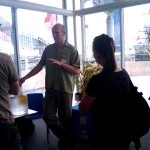.

The story continues …
Krill face deadly cost of ocean acidification
New research on the impact of ocean acidification on Antarctic krill has found increased levels of carbon dioxide kill their embryos.
The Australian Antarctic Division study exposed krill to different levels of carbon dioxide to assess the possible impact of acidification on the early development of krill.
Ocean acidification is caused by man-made carbon dioxide from the atmosphere being absorbed by the ocean.
Krill biologist, Dr So Kawaguchi, said most of the krill embryos exposed to higher levels of carbon dioxide did not develop and none of them hatched successfully.
“We used the Antarctic Division’s krill aquarium to set up three sea water tanks bubbled with the current (380 parts per million (ppm)), medium (1000ppm) and high (2000ppm) levels of carbon dioxide,” Dr Kawaguchi said.
“There was no change detected in the development of the krill embryos in the tanks with the current and medium levels, but in the tank with higher levels, none of the embryos survived to hatch.”
Additionally the acidity of the ocean is not uniform throughout the water column, with higher levels of carbon dioxide found at greater depths.
Southern Ocean carbon dioxide levels at depths could rise to 1400 ppm by the year 2100, when atmospheric carbon dioxide is expected to more than double to 788 ppm.
“If carbon dioxide increases to these levels and the ocean becomes more acidified, it could have a huge impact on krill populations and therefore the entire Southern Ocean ecosystem.”
“Krill spawn eggs at the surface which then sink to between 700 and 1000 metres before the larvae hatch and swim back to the surface,”
“Hence vertically migrating animals like krill will experience one of the most drastic changes in the ocean and potentially face greater mortality.”
The Southern Ocean is expected to be most severely affected by ocean acidification with cold water taking up carbon dioxide more readily.
Further studies will be undertaken to identify the exact carbon dioxide concentration “tipping point” and the potential impact of ocean acidification on the later stages of the life cycle of krill.
Australian Antarctic Division website, 13 October 2010
